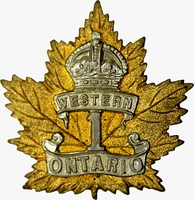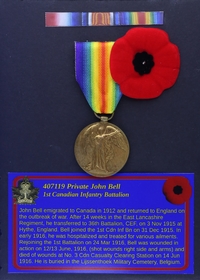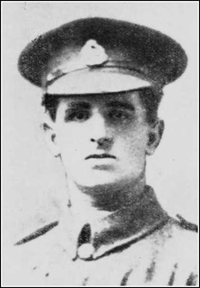
407119 Private John Bell
1st Canadian Infantry Battalion
By: Capt (ret'd) Michael M. O'Leary, CD, The RCR
John Bell was born in Lancashire, England on 24 Oct 1889 (or 1888, tbc). His birthdate is recorded inconsistently in his service record and is even noted on his attestation form as 1899, conflicting with the apparent age of 26 noted on the reverse of the same form.
Bell enlisted for service in the Canadian Expeditionary Force (C.E.F.) at Hythe, England, on 3 Nov 1915, being taken on strength of the 36th Reserve Battalion at West Sandling. He was one of the small number of British citizens permitted to enlist with the Canadians in England. A farm labourer, Bell is described on his attestation form as 5 feet 4 inches in height, with a 35 ½-inch chest, a fair complexion, blue eyes, and dark brown hair. Under prior service, an initial entry of "No" was crossed out and replaced with "14 weeks, East Lancashire Regiment." Bell identified his sister, Annie Bell of Newholme St., Barrowfords, Lancs., Eng., as his next of kin. His religious denomination was Wesleyan.
On 31 Dec 1915, Bell was transferred to the 1st Canadian Infantry Battalion, C.E.F., and embarked for France. The following day, he is shown as having been taken on the strength of the 1st Battalion as a reinforcement from the 36th Reserve Battalion.
Bell spent a little more than a week at the Canadian Base Depot at Le Harve. Departing the C.B.D. on 9 Jan 1916 he joined the 1st Battalion in the field two days later.
Front line trenches, support trenches, reserves, marching, and training were the perpetual cycle of the infantry battalions on the Western Front. Few tours of the front lines were without casualties, and even when out of the most forward trenches, the reach of enemy artillery could take its toll. In the weeks after Bell's arrival, the 1st Battalion alternated between the forward trenches and reserve tasks. The activities of the 1st Battalion are summarized in the unit's "Battle Bar Document" (prepared after the war by the Militia Department in anticipation of the possibility of clasps for the British War Medal):
- 7-30 Jan 1916; Corps Reserve (Training carried on in Corps Reserve)
- 31 Jan – 2 Feb 1916; Forward Line of Troops
- 3-6 Feb 1916; Brigade Reserve
- 7-12 Feb 1916; Forward Line of Troops
- 13-18 Feb 1916; Divisional Reserve
Bell's first period of service with the 1st Battalion included two tours of the front line trenches, from 31 Jan to 2 Feb and again from 7-12 Feb 1916. Relatively quiet tours of the line, the battalion reported a few soldiers wounded but nothing more serious. Once moved into Division Reserve at Dranoutre on the evening a 12 Feb, soldiers of the 1st Battalion had a chance to clean up, attend the baths, and parade for inoculations. While Bell's service record does not include details of the inoculations received by the battalion, the February 1916 War Diary of the Assistant Director of Medical Services, 1st Canadian Division, notes that on 12 Feb 1916, "Inoculation against Paratyphoid begins."
Bell's inoculation against paratyphoid didn't prevent him from him catching another infectious disease that took many soldiers out of the battalions. On 18 Feb 1916 he was admitted to No. 2 Canadian Field Ambulance. His initial diagnosis was "influenza."
As Bell moved rearward in the medical evacuation system, his diagnosis changes. On 19 Feb 1916, he was transferred to No. 1 Canadian Field Ambulance with "acute arthritis, both legs." Two days later, on 21 Feb 1916, he went to No. 2 Canadian Convalescent Depot suffering from "chronic myalgia, joints," a general diagnosis for muscular pain. The following day he transferred again, by No. 5 Ambulance Train and on 23 Feb 1916 was admitted to 18 General Hospital with "acute rheumatism."
Soon after, on 25 Feb 1916, Bell moved again when he was transferred to No. 3 Canadian Field Ambulance from No. 1 Can. Fd. Amb. with "acute arthritis." With this move he was transferred from the 1st Battalion to the Canadian Base Depot as his parent unit for administration while under treatment and recovery.
On 8 Mar 1916, Bell was admitted to No. 6 Convalescent Depot, Etaples, with myalgia. He spent two more weeks recovering and on 22 March left the C.B.D. to rejoin the 1st Battalion in the field on 24 Mar 1916.
The summary of activities of the 1st Battalion in the following months as found in the "Battle Bar Document" follow:
- 21-25 Mar 1916; Brigade Reserve
- 26-31 Mar 1916; Corps Reserve
- 2 Apr 1916; Brigade Reserve
- 3-9 Apr 1916; Forward Line of Troops
- 10-15 Apr 1916; Brigade Reserve
- 16-23 Apr 1916; Divisional Reserve
- 24 Apr – 1 May 1916; Forward Line of Troops
- 2-9 May 1916; Brigade Reserve
- 10-17 May 1916; Divisional Reserve
- 18- 25 May 1916; Forward Line of Troops
- 25 May – 1 Jun 1916; Brigade Reserve
- 2-3 Jun 1916; Local support
- 4-5 Jun 1916; Forward Line of Troops
- 6-8 Jun 1916; Local support
- 9-11 Jun 1916; Divisional Reserve
- 12 Jun 1916; Local support
- 13 Jun 1916; Forward Line of Troops
While some of the days in the forward line were apocryphally "quiet on the western front," other days were premonitions of battles yet to come. On 30 Apr 1916, the Battalion's War Diary noted the casualties to that date on the front line tour it was finishing as one attached officer killed, one officer wounded, 32 other ranks killed, and 61 other ranks wounded. Most of these occurred during heavy bombardment of the 1st Battalion's trenches on 26 Apr 1916. The Battalion suffered again during its front line tour of 18 to 25 May 1916. casualties noted in the War Diary were one officer and 11 other ranks killed, and one attached officer and 28 other ranks wounded.
On 11 Jun 1916, while the unit was in Divisional Reserve, Bell completed the Will Form in his pay book. In this will he states: "If anything should happen to me while I am in action, please send all that I have such as my watch and money to Mrs. T. Bell, Castle Hill, Settle, Yorks., England."
Late on 12 Jun 1916, the 1st Battalion returned to the forward line of trenches from a local support role for one day in action on the 13th. The battalion's task was to support a counter-attack being conducted by the 3rd Canadian Infantry Battalion at Mount Sorrel and that unit's consolidation of the captured position.
The War Diary of the 1st Battalion offers few details on the actions of 12 and 13 June 1916. An appendix to that month's War Diary offers a sparse explanation of the movements of companies, but few contextual details to illustrate the battlefield conditions experienced by the unit's soldiers.
The 3rd Battalion's War Diary offers a little more details. Their attack had reached the German front lines with heavy losses, and they were beginning to consolidate their gains under continual heavy German artillery fire. Their Diary mentions the 1st Bn.:
"The 1st Canadian Battalion, in support, sent a company forward to 1st German line, and later sent two companies, and then the remaining companies forward to our regained front line to help consolidate and hold the position."
Major Mason, 3rd Battalion, was in charge of the efforts in those forward positions. He was subsequently wounded and with the majority of the 1st Battalion deployed forward, command of the position went to Lieut.-Col. F.A. Creighton, the Commanding Officer of the 1st Battalion. The paucity of details in the 1st Battalion's War Diary likely reflects the difficulties that arose with the German shell that struck the forward headquarters location on 13 June, incapacitating Lieut.-Col. Creighton and killing an officer of the 3rd Battalion. The 1st Battalion was not able to evacuate the Colonel from the battlefield until a stretcher party returned two days later, sadly he died soon after being carried to a Casualty Clearing Station.
Perhaps the most telling information on the 1st Battalion's experience on the 13th of June, 1916, is the unit Roll of Honour. Fifty-one (51) names on the roll have a date of death of 13 Jun 1916. Forty-seven (47) of these are listed on the Ypres (Menin Gate) Memorial, i.e., soldiers who fell in Belgium with no known graves. The last line in the Appendix to the War Diary adds one more facet of the experience of those who were ht by enemy fire; "Stretchers. The supply was inadequate. Wounded men has to be left where they fell for a considerable time, which has a demoralizing effect on all who see them." (Having fought over the same ground, for comparison the 3rd Battalion's casualties were recorded as officers: 3 KIA, 1 DOW, 1 missing, and 11 wounded; and other ranks; 40 KIA, 92 missing, and 207 wounded.)
Private John Bell of the 1st Canadian Infantry Battalion was one of the few who were found and carried off that bloody battlefield. Sadly, the next day, on 14 Jun 1916, he died of wounds received in action at No. 3 Canadian Casualty Clearing Station. His wounds were noted as "S.W. [shot wounds, which could be by bullet, shrapnel, or splinter] of his right side and arm.
Unlike the many whose remains were not recovered and identified from the Mount Sorrel battlefield, Bell has a known grave. John Bell was buried in the Lijssenthoek Military Cemetery, located 1 ¾ miles South West of Poperinghe, Belgium (Sheel 27 L.22.d.6.3).
On the closing of Bell's pay account, there was $128.28 on the outstanding balance. In his effects, another $9.73 was found.
For his service in the C.E.F., Bell was entitled to receive the 1914-15 Star, the British War Medal, and the Victory Medal. At first glance, his being taken on the strength of the 1st Battalion on 1 Jan 1916 appears to make him one day late for eligibility for the 1914-15 Star. But a more critical examination of his record shows the inherent challenges in recording actual events vice meeting military expectations in administrative records.
A soldier can't belong to two units on the same day, and it must be clear which unit is responsible for him each day for purposes of pay, rations, and other entitlements. John Bell's last day in England was 31 Dec 1915 and that's the day he crossed the Channel and was struck off the strength of the 36th Reserve Battalion. The following day, 1 Jan 1916, he is shown as taken on the strength of the 1st Battalion, even though he had only arrived at and remained at the Base Depot. While for administrative purposes, Bell belonged to one unit on one day and another unit on the next day, in reality as soon as he arrived in France on 31 Dec 1915 he was on the roll of the 1st Canadian Infantry Battalion, a unit in the Theatre of War. Being on the roll of a unit in theatre before the end of 1915 made him eligible to receive the 1914-15 Star as one of his service medals.
Bell's medals were despatched to his father, Mr. Tom Bell, 1 Castle Hill. Settle, Yorks. Eng., on 17 May 1921. In addition to his medals, Bell's father would also receive a Memorial Plaque and Scroll. Notably, although Bell's step-mother was identified on his medal card, she would not receive a silver Memorial Cross.
Pro Patria
Visit a randomly selected page in The O'Leary Collection (or reload for another choice):
- The O'Leary Collection; Medals of The Royal Canadian Regiment.
- Researching Canadian Soldiers of the First World War
- Researching The Royal Canadian Regiment
- The RCR in the First World War
- Badges of The RCR
- The Senior Subaltern
- The Minute Book (blog)
- Rogue Papers
- Tactical Primers
- The Regimental Library
- Battle Honours
- Perpetuation of the CEF
- A Miscellany
- Quotes
- The Frontenac Times
- Site Map
QUICK LINKS
The O'Leary Collection—Medals of The Royal Canadian Regiment
Newest additions:
![]()
![]() SB-12725 Private Henry "Hank" Ard
SB-12725 Private Henry "Hank" Ard ![]()
WIA at Hill 187, Died of Wounds in Japan
![]()
![]() 2355331 Lance Corporal Albert Lorking
2355331 Lance Corporal Albert Lorking
Wounded in action, later a War Amps representative.
![]()
![]() 4334 / 477996 Pte Isaac Hamilton Wilcox
4334 / 477996 Pte Isaac Hamilton Wilcox
Permanent Force, South Africa, and C.E.F.
![]()
![]() 477019 Private Harold Ashcroft
477019 Private Harold Ashcroft
Transferred to the Tunnelers.
![]()
![]() 734231 Private Clark D. Thompson
734231 Private Clark D. Thompson ![]()
The older Thompson brother, killed in action.
![]()
![]() 733849 Private Norman Parker Thompson
733849 Private Norman Parker Thompson
The younger Thompson brother; post-war service in the Special Guard.
![]()
![]()
![]() A305 / 400305 Private Andrew Walker
A305 / 400305 Private Andrew Walker ![]()
"Previously reported Wounded, now Killed in Action."
![]()
![]() 823298 Pte Thomas Patrick Steele, M.M.
823298 Pte Thomas Patrick Steele, M.M. ![]()
… for gallant conduct in the field …
![]()
![]() P13066 Sergeant Harold Thompson
P13066 Sergeant Harold Thompson
Instrumental Soloist for over 20 years of Canadian Army service.
![]()
![]() 9609 / 477728 Private Albert Edward Piper
9609 / 477728 Private Albert Edward Piper
"Arrived from England as a STOWAWAY …"



